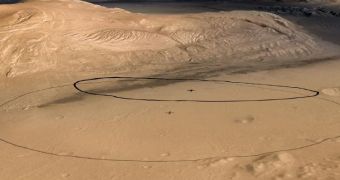Officials at the NASA Jet Propulsion Laboratory (JPL), in Pasadena, California, say that they have recently been able to refine the target landing ellipse for the Mars Science Laboratory (MSL) rover Curiosity. The vehicle will reach its destination soon.
The study that yielded the new landing coordinates was made possible by the fact that scientists now have increased confidence in the precision landing technologies employed by the MSL. The mission is the first to make use of the revolutionary Sky Crane system.
Rather than landing on airbags, like the Mars Exploration Rovers (MER) before it, Curiosity will be deployed on the surface by a rocket-powered platform, which will hover mid-air, and lower it to the ground via several cables.
Once the rover touches down, the cables will separate, and the Sky Crane will fly away, crashing a couple of kilometers away. Since JPL researchers – who manage the MSL mission – are now confident that the system will work, they believe they can land the 1-ton robot closer to its prime science target.
By narrowing down the exact location where the MSL will land, the team is able to shave a few months off the total mission, time that would have otherwise been used to travel from the nearest safe landing site to the slopes of Mount Sharp, at the center of Gale Crater.
Each spacecraft landing on another celestial body has a designated landing area, which is usually shaped as an ellipse. What investigators at the JPL did was make the ellipse smaller, while at the same time ensuring that mission safety remains a priority.
“We're trimming the distance we'll have to drive after landing by almost half. That could get us to the mountain months earlier,” JPL MSL project manager Pete Theisinger explains. He adds that Curiosity is scheduled to land on Mars at 0631 GMT, on August 6 (10:31 pm PDT, August 5).
“We have been preparing for years for a successful landing by Curiosity, and all signs are good. However, landing on Mars always carries risks, so success is not guaranteed,” explains NASA MSL program executive Dave Lavery.
“Once on the ground we'll proceed carefully. We have plenty of time since Curiosity is not as life-limited as the approximate 90-day missions like NASA's Mars Exploration Rovers and the Phoenix lander,” he concludes.

 14 DAY TRIAL //
14 DAY TRIAL //